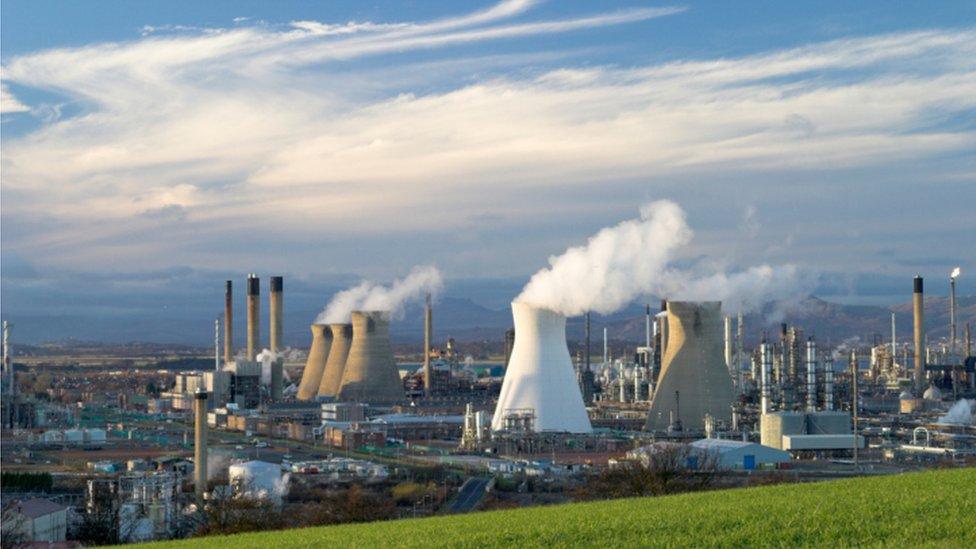The taxing question of Scotland's growth
- Published

Much of the success within the production sector in the final quarter of 2015 was driven by output from the Grangemouth complex
Economic output from Scotland's economy has never mattered so much. It's not just that there's an election campaign going on.
Indeed, it's an odd campaign where sluggish growth figures have not been robustly deployed.
No, it's more because the figures have been published on the morning that Scots start paying a large slug of their income tax to the Scottish Parliament.
The Scottish Rate of Income Tax is no longer in preparation. It is now a reality. And it may become clear on your next pay slip, if you're fortunate enough to get one.
Lagging
Of course, if your income doesn't grow, then you won't be paying more income tax.
And that's why it should matter to Holyrood that growth was up only 0.2% in the final quarter of last year, it fell in the previous quarter, and growth between the end of 2014 and the end of 2015 was more than twice as high across the UK (2.1%) as it was across Scotland (0.9%).
The same pattern was issued by motor trade at the same time as economic growth. New car registrations were up in the vital March market, when there are new number plates available, but by only half the rate for the rest of the UK.

If there is a significant lag in growth between Scotland and the rest of the UK, a gap will open up in the trajectory of income tax revenue.
This need not affect the total budget, if the long-negotiated Fiscal Framework kicks in as we're told it should. That deal should ensure that the block grant transferred from the Treasury to Holyrood should make up that gap.
It does so because one of the main explanations for Scotland's more sluggish growth rate is its relatively slow rate of population growth.
Indeed, last year's growth in economic output per head in Scotland - if you take the whole of 2015 and compare it with the whole of 2014 - is one notch ahead of the UK as a whole - by 1.6% to 1.5%. So it's no surprise that that has been the number highlighted by the Scottish National Party as it campaigned for the 5 May ballot.
(These figures, it should probably be explained, are published by the Scottish government, but their content and timing is for the statisticians - meaning they should be kept away from any ministerial influence.)
Feeling prosperous
Economic growth per head was one positive note out of these latest figures. And perhaps it matters most, as it is a guide to how prosperous we are and feel.
But the other figures confirm other evidence that this has been a pretty tough time for many parts of the economy.
Indeed, output per head is still below the pre-recession peak it previously reached in the second quarter of 2008. That's right - by this measure, the average Scot is doing no better than eight years ago.
In the past 18 months, it has been the oil and gas sector that has been a big influence on the downbeat mood in the Scottish economy.
While the element that includes oil and gas fell by 4% from the end of 2014 to December 2015, there were much bigger falls in sectors that play a big part in the offshore supply chain, and which often look for orders to Aberdeen procurement managers.
The "metals and metal products" category, for instance, was down by a whopping 18.2% from one year end to the next, and "computers and electrical" fell by 8.4% over 2015.
The stand-out success within the production sector during October to December was "refined oil, chemicals and pharmaceuticals".
Much of that is driven by output from the Grangemouth complex. It was up by 5.3% in the final quarter of the year, yet by 4.7% over the year as a whole - the same annual growth rate as "food, beverages and tobacco".
In the dominant services sector, which accounts for nearly three-quarters of the economy, there is a story of growth, but it's a slow one, and its trajectory is not very clear.
Financial services were up at the end of the year, but down over the whole year, and business services (which is a very large sector) showed the reverse of that picture.
Building blocks
Construction has held up Scottish output through some tough quarters recently, growing by an impressive 10.8% last year, and a stunning 20% during 2014.
Some of that can be explained by public sector construction, including the M8 and M74 upgrades in Lanarkshire, the Queensferry Crossing and the Aberdeen ring road as well as housing, hospitals and schools.
But that doesn't fully explain how strong construction growth has looked. John McLaren, a seasoned scrutineer of these figures (formerly at the mothballed Fiscal Affairs Scotland economics consultancy), is one of those who doesn't fully trust them.

On recent evidence of revision by the statisticians, there are further grounds for such suspicions. The third quarter of last year was revised down and into a contraction of total output. That brought an end to nearly three years of continuous quarterly growth figures.
If the same happens to the most recent figures for the last quarter of 2015, two quarters of contraction would mean Scotland has been in recession. But of course, we'll only find out once it has pulled back into growth again. Those next revisions are published in July.
Those on the Holyrood campaign trail have to make do with the numbers now available. And they have been published at a good time to remind candidates and party strategists that there is more to Holyrood's powers over the next five years than taxing, spending and safeguarding services.
Decisions made by the MSPs elected on the morning of 6 May can help determine the size of the economy from which those taxes will be drawn. With manifestos out soon, you might want to ask about their plans to get Scotland's economic growth rising.